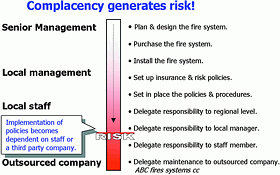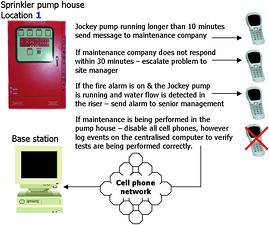
What is the most likely element to fail when it comes to managing and monitoring fire protection equipment? Unfortunately it is the old cliché of the `weakest link' and it is normally the human factor.
A company may put many policies and risk procedures in place to handle many types of event from an actual fire, to procedures that should be followed if certain pieces of equipment should fail. However, if people are involved then weaknesses are inherent.
* Staff short cut company procedures and create their own.
* 'Interpretation' of policies changes the further down the delegation line you go.
* Staff take short cuts when it is not their property or they have no vested interest.
* Staff become complacent because responsibility is delegated right down to an outsourced third party company, in other words: "It is no longer my problem, I am not responsible".
* Management becomes complacent that installed policies and procedures are adhered to.

Complacency is a dangerous attitude that slowly materialises within any organisation. It manifests because people expect that their procedures are being followed to the letter, confirmed by the lack of incidents brought to their attention, therefore the policies must be working! Only when a facility burns down are the policies investigated and procedural failures are brought to light.
Why incidents and problems rarely reach management level
* Management is complacent that the policies and procedures implemented are being initiated.
* There are no tools to create the required reports. How can management investigate an incident if there is no data to initiate an investigation?
* There are no policies to keep a hard copy of incidents or events.
* Third party maintenance company's service delivery cannot be checked against service level agreements; once again there are no tools in place to facilitate this.
Here is the catch, management see no reason to install a management system as there have been no incidents to justify its implementation, meanwhile at the coal face.
Equipment is not being maintained correctly. Test procedures are not being followed or implemented. Incidents are not logged or reported. Risks are taken that would jeopardise insurance policies if brought to light.
An actual event
A sprinkler pump house was downgraded for several weeks while the electric pump was taken away for a major refit, leaving only the diesel pump as protection. Management was aware of the downgrade and informed the insurance company of the increased risk. What management was not aware of was that the automatic choke on the diesel pump was faulty and it would not start. The system simply would not have worked if a fire had occurred.
The maintenance company who removed the electric pump put up a sign stating 'Do not switch ON'. The personnel responsible for testing took the message literally and did not test the remaining equipment the entire time the electric pump was gone. Therefore the true risk was never brought to management's attention even though they correctly followed their own internal policies.
Had a proper management system been installed, the diesel failure to start would have been logged weeks earlier during diesel start testing, and the lack of testing of the diesel equipment during this period would have been apparent.
Removing the weakest link?
If people are the weakest link then surely it makes sense to automate as many of the procedures as possible where human failure could affect a company's safety. In other words implement a system that:
* Requires no onsite management or computer systems that need supervision.
* Automatically make independent critical decisions based on policy rules.
* Automatically escalate events that are not corrected or attended to.
* Automatically generate offsite logs to facilitate incident investigation.
Why do existing management services fail?
Some pump houses are connected to building management systems; however, the messages are often unclear or misleading, for example it will say that the diesel pump started when in fact it was an attempted diesel pump start, it never actually happened. They often only generate cryptic messages with no detail.
They also have no intelligence, and therefore generate too many non-essential messages, which become bothersome, and staff members start to ignore them; they cannot escalate problems to management where staff have not responded; they cannot combine alarms to raise the criticality level and generate a new alarm event; and they cannot assist in verifying maintenance and test procedures are correctly followed.
A true management system needs to be self contained, intelligent, require no-onsite management or maintenance, and have the capabilities to inform relevant personnel about failures or problems related to them.
A managed pump house
An intelligent system requires logic, for example, 'do not let me know when the jockey pump starts or stops, it is supposed to do that, however, let me know if either of the following two conditions occur.
Jockey pump runs for longer than 10 minutes or;
Jockey pump starts more than five times in a 1-hour period'.
Both of these conditions could mean that there is a water leak somewhere in the water system and a flood may be occurring.

Accurate data is essential
The worst possible scenario would be to introduce a system based on SMS technology only to find that no one can agree on what events actually occurred as each staff member has a different event time on his or her phone. When a message is received via cellular phone, the date and time displayed is the date and time the networks received the message, It does not represent the date and time of the event that caused the message.
What is needed is accurate data to generate meaningful reports and statistics. To solve this problem Securlogic added an 'Incident' date and time to the message before it is sent that displays accurately the actual time the event occurred so that everyone concerned would have identical data. A sequence number is also added so that if the messages are delivered out of sequence by the cellphone networks, then the actual order the events occurred can be reconstructed.
Two years ago, Securlogic was asked to develop an SMS-based management system to manage fire pump houses with all the business rules that were required. The company soon discovered that no currently available SMS alarm technology was fit for the purpose, quite simply they were too basic. After two years of development the company produced an intelligent fire pump house management system called the RS1000FM. It is a cost-effective solution to protect the investment in pump house equipment and the facilities they are designed to protect.
The product is also being implemented to manage:
Security sites - control all the disparate equipment from security alarm panels, UPS, DVR alarms and then add business rules and escalation policies.
Computer rooms - with 32 alarm inputs everything can be properly managed and alarms escalated.
Elevators - with its two-way voice call option - a control room can communicate with the lift occupants.
Hospitals - one board can monitor everything within the hospital - refrigeration, fire alarm and critical gas.
Paul Nagle is the managing director of Securlogic, an independent South African company that specialises in developing high technology solutions for niche industry needs. www.securlogic.co.za
© Technews Publishing (Pty) Ltd. | All Rights Reserved.